
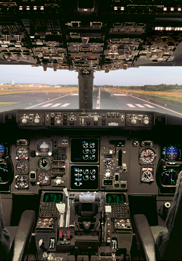
Airlines should make sure they update their inertial reference systems to the latest magnetic variation (MagVar) tables in order to avoid potentially hazardous magnetic heading-related navigation errors.
By Benjamin Weinstein, Avionics Design Engineer
Airlines are responsible for MagVar updates, which can be performed during scheduled maintenance.
MagVar tables need to be updated periodically to ensure their accuracy since the Earth’s magnetic field is constantly changing. Responsibility for MagVar updates falls to the airlines, depending on their areas of operation. While the most recent MagVar tables were updated in 2005, some airlines are still using the 1980 version of the tables. Airplanes using these tables as the primary source for heading while flying raw-data non-directional beacon (NDB) approaches in certain parts of the world can have significant heading errors. In certain situations, the heading error may result in the airplane flying off course when trying to acquire a specific NDB bearing. In the approach environment, this significantly increases the risk of striking obstacles outside of the Terminal Instrument Procedures secondary area during the approach.
While no NDB incidents have been reported in service, crews have commented about MagVar-related system effects.
This article provides background information about MagVar tables, explains the NDB approach issue, and provides recommendations for airlines that are not using current versions of the tables.
ABOUT MAGVAR TABLES
MagVar tables are used to convert true heading to magnetic heading in an airplane’s inertial reference unit (IRU). Magnetic heading accuracy is also the basis for requirements of other systems, including displays and autoflight.
These tables, which are the primary source of magnetic variation for adjusting the heading from true to magnetic, are updated in 10-year intervals due to changes in the Earth’s magnetic field and primarily to correct for movement of the magnetic poles. Updates were made in 1995 and 2005; the next scheduled update is 2015.
For example, a pilot using outdated MagVar tables as the primary source for an airplane’s heading while flying NDB approaches in certain parts of the world can experience heading errors exceeding 10 degrees (see fig. 1).
Figure 1: Deviation in degrees of magnetic variation tables, 2005 vs. 1980
Airplanes operating in certain areas of the world — primarily South America and northern parts of North America — can have heading errors exceeding 10 degrees. (Dark red indicates greater than 10 degrees of error; dark blue indicates 0 degrees of error.)
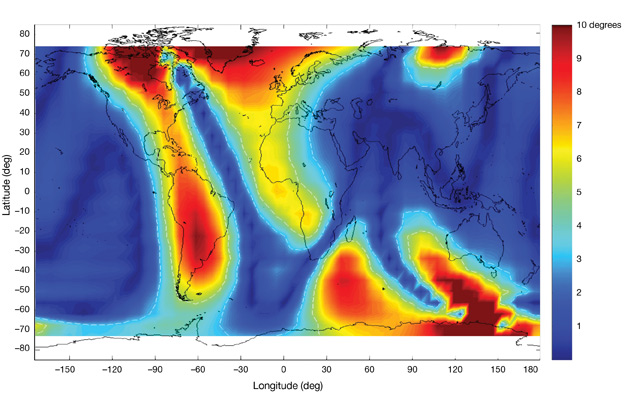
NDB APPROACH ISSUE
When flying an NDB approach, a pilot is using raw data that includes magnetic heading information. Similar to other approach types, the NDB procedure final approach segment is designed as a trapezoid with primary and secondary obstruction clearance zones. Obstruction clearance is assured within the final approach segment when complying with the published altitude constraints. Obstacles outside these areas have no assured vertical obstacle clearance. Consequently, operating the airplane during an NDB instrument approach outside these areas can be hazardous. Pilots can use the NDB for an approach directly to the runway or for an arrival setup to locate the instrument landing system.
MagVar information that is off by 10 degrees can result in these situations:
When flying toward the NDB: Can rotate the perceived approach into the secondary area, which may allow the airplane to be outside the secondary area and increases the hazard to the airplane (see fig. 2).
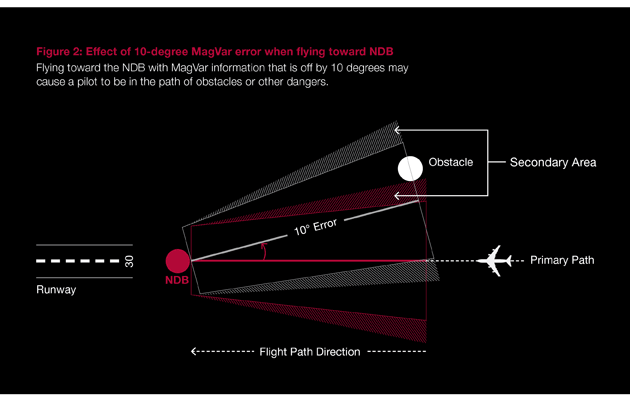
When flying away from the NDB: Can cause the pilot to be off course up to 2.5 miles to the right or left of the runway on final approach (see fig. 3).
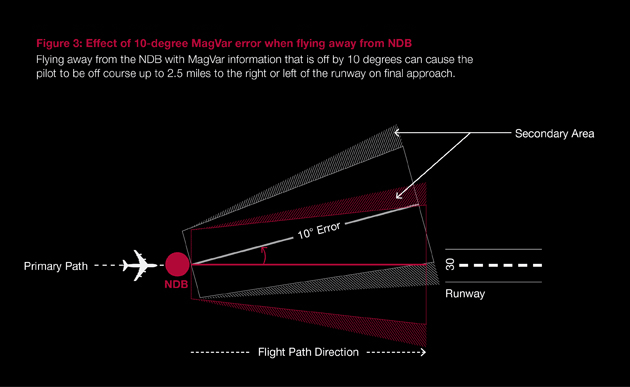
Boeing strongly recommends that airlines flying with 1980 MagVar upgrade to the latest MagVar tables. IRU MagVar software updates are performed by Honeywell at its service centers, by approved third-party repair centers, or by airlines approved by Honeywell. Airlines should incorporate these updates into their established maintenance schedule. The MagVar update is also necessary to maintain certification compliance in areas of large magnetic change. Consult your local regulatory agency for local compliance requirements.
Current deliveries of Boeing airplanes incorporate the most recent 2005 MagVar tables. However, updated MagVar tables may or may not be available depending on the product model and the entry into service date (see fig. 4).
Figure 4: Service bulletins (SBs) and service letters (SLs) that address outdated MagVar tables
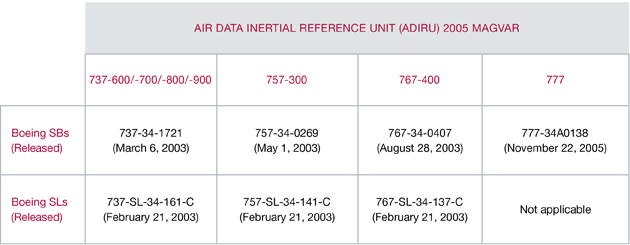
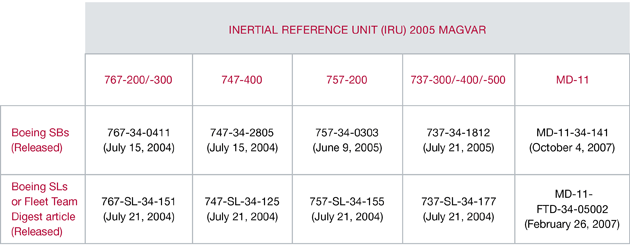
SUMMARY
Older MagVar tables will result in magnetic heading errors in the IRUs. These heading errors can have an effect on NDB approaches. These potential problems can be avoided by updating the IRUs with the most recent MagVar table data. Airlines are responsible for MagVar updates based on their areas of operation. The update can be performed during scheduled maintenance.
For more information, please contact Steve Hopkins.

